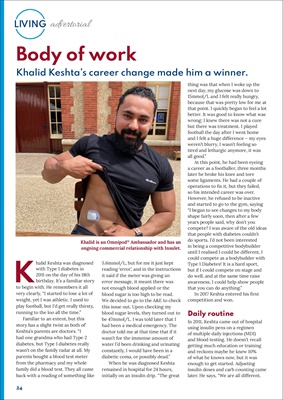
24
LIVING
Body of work
Khalid Keshta's career change made him a winner.
Khalid Keshta was diagnosed
with Type 1 diabetes in
2011 on the day of his 18th
birthday. It's a familiar story
to begin with. He remembers it all
very clearly, "I started to lose a lot of
weight, yet I was athletic. I used to
play football, but I'd get really thirsty,
running to the loo all the time."
Familiar to an extent, but this
story has a slight twist as both of'
Keshta's parents are doctors. "I
had one grandma who had Type 2
diabetes, but Type 1 diabetes really
wasn't on the family radar at all. My
parents bought a blood test meter
from the pharmacy and my whole
family did a blood test. They all came
back with a reading of something like
thing was that when I woke up the
next day, my glucose was down to
15mmol/L and I felt really hungry,
because that was pretty low for me at
that point. I quickly began to feel a lot
better. It was good to know what was
wrong; I knew there was not a cure
but there was treatment. I played
football the day after I went home
and I felt a huge difference - my eyes
weren't blurry, I wasn't feeling so
tired and lethargic anymore, it was
all good."
At this point, he had been eying a
career as a footballer, three months
later he broke his knee and tore
some ligaments. He had a couple of
operations to fix it, but they failed,
so his intended career was over.
However, he refused to be inactive
and started to go to the gym, saying
"I began to see changes to my body
shape fairly soon, then after a few
years people said, why don't you
compete? I was aware of the old ideas
that people with diabetes couldn't
do sports. I'd not been interested
in being a competitive bodybuilder
until I realised I could be different, I
could compete as a bodybuilder with
Type 1 Diabetes! It is a hard sport,
but if I could compete on stage and
do well, and at the same time raise
awareness, I could help show people
that you can do anything."
In 2017 Keshta entered his first
competition and won.
Daily routine
In 2011, Keshta came out of hospital
using insulin pens on a regimen
of multiple daily injections (MDI)
and blood testing. He doesn't recall
getting much education or training
and reckons maybe he knew 10%
of what he knows now, but it was
enough to get started. Adjusting
insulin doses and carb counting came
later. He says, "We are all different.
5.6mmol/L, but for me it just kept
reading 'error', and in the instructions
it said if the meter was giving an
error message, it meant there was
not enough blood applied or the
blood sugar is too high to be read.
We decided to go to the A&E to check
this issue out. Upon checking my
blood sugar levels, they turned out to
be 47mmol/L. I was told later that I
had been a medical emergency. The
doctor told me at that time that if it
wasn't for the immense amount of
water I'd been drinking and urinating
constantly, I would have been in a
diabetic coma, or possibly dead."
When he was diagnosed Keshta
remained in hospital for 24 hours,
initially on an insulin drip. "The great
advertorial
Khalid is an Omnipod® Ambassador and has an
ongoing commercial relationship with Insulet.